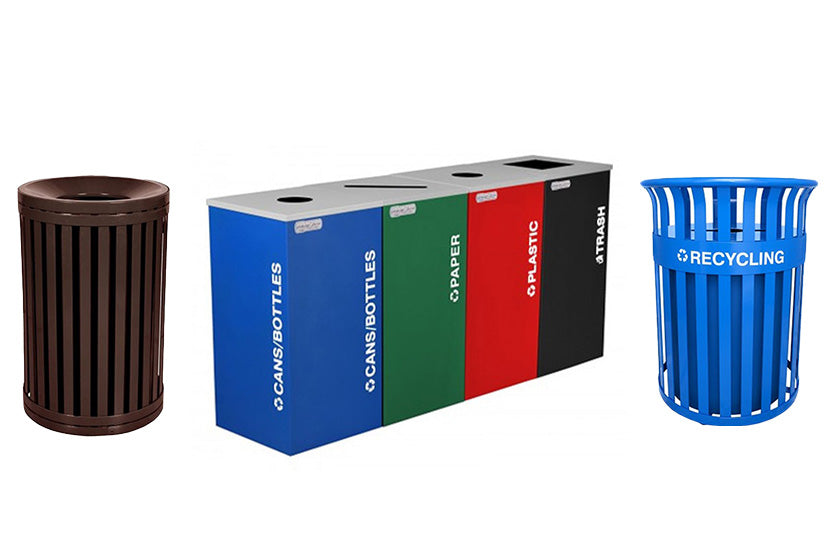Selecting the right waste receptacle is a vital part of waste management in any facility. This choice is influenced by various factors, such as the type of waste generated, the facility's size, and location, the receptacle's capacity, and more. This comprehensive guide will help you navigate these factors to choose the perfect receptacle for your facility.
Understanding Your Waste Management Needs
Different types of facilities produce different types of waste, which may require distinct waste receptacles. For instance, offices predominantly produce paper waste, while restaurants generate food waste. A thorough understanding of your waste management needs is the first step towards choosing the right waste receptacle.
Type of Facility
The choice of waste receptacle can significantly differ depending on the type of facility. For instance, Ex-Cell Kaiser waste receptacles might be ideal for office buildings due to their sleek design and capacity, while Justrite waste containers are better suited for hazardous waste disposal in laboratories or hospitals.
Types of Waste Receptacles
Waste receptacles vary significantly, and your choice will depend on your specific needs. You can find a range of options in the market, including outdoor and indoor trash cans, recycling bins, compost bins, and hazardous waste containers. Each of these options serves a specific purpose and comes with its unique set of features and benefits, as explained in our comprehensive waste receptacle guide.
Choosing the Right Size and Capacity
Consider factors like the number of people using the facility, the type and amount of waste generated, and the frequency of waste collection when choosing the size and capacity of your bins. Larger facilities with high foot traffic will require larger or more numerous bins, while smaller ones might do well with fewer, smaller bins.
Material Considerations
Waste receptacles are typically made from plastic or metal, each with its benefits and drawbacks. Plastic bins are often more affordable and lightweight, while metal bins are more durable and offer a sleeker design.
Location and Placement of Bins
The location and placement of bins are essential for optimal use. Ensure they are easily accessible, highly visible, and positioned in areas where waste is most likely to be generated, such as near desks, kitchens, and restrooms.
Recycling and Composting Options
Promoting recycling and composting in your facility is not only environmentally friendly but can also help reduce waste disposal costs. Having separate bins for these purposes encourages users to sort their waste, aiding in recycling and composting efforts.
Regulatory Requirements
Understanding and adhering to local, state, and federal regulations concerning waste disposal is crucial. For example, certain types of waste may need to be disposed of in specific ways, and failure to comply with these regulations could result in fines or penalties.
Budget Considerations
Balancing budget constraints with your waste management needs is a necessary part of the process. It's important to understand that investing in high-quality, durable bins can save money in the long run by reducing the need for frequent replacements.
Aesthetics and Design
Waste receptacles can also contribute to the overall aesthetics of your facility. Choose designs and colors that complement your decor to maintain a cohesive look and feel throughout your facility.
Maintenance and Cleaning
The ease of cleaning and maintenance is an essential consideration when choosing your waste receptacles. Receptacles that are easy to clean and maintain can help maintain a clean, sanitary environment.
Sustainability Considerations
In line with global trends towards sustainability, you might want to consider eco-friendly or sustainably-made waste receptacles. Receptacles made from recycled or renewable materials can help reduce your facility's carbon footprint.
Features and Innovations
Modern waste receptacles come equipped with features like touchless operation, odor control, and smart capabilities. Touchless trash cans help maintain hygiene by reducing contact, while odor control features help keep the environment fresh. Smart waste bins can even inform you when they're about to be full, optimizing waste management operations.
Brand Selection
Choosing a reputable brand ensures you get high-quality products and excellent customer service. Factors to consider include the brand's experience, the range of products they offer, their delivery and installation services, and customer reviews. Trusted brands like Source 4 Industries provide a variety of waste receptacle options to meet your specific needs.
In addition to the above considerations, other factors that may influence your choice include the bin's durability, security features (especially for outdoor bins), and ease of use. Always remember that the right waste receptacle for your facility not only simplifies waste management but also contributes to the overall efficiency and aesthetics of your environment.
So, take the time to evaluate your needs, explore the options, and make an informed decision. Whether you're running an office, a restaurant, a school, or a hospital, making the right choice can make a world of difference in how your facility handles waste. Don't forget to revisit your needs regularly, as they may change over time with the evolution of your facility.



